Basu P. Biomass Gasification and Pyrolysis: Practical Design and Theory
Подождите немного. Документ загружается.


Design of Biomass
Gasifiers
Chapter 6
Biomass Gasification and Pyrolysis. DOI: 10.1016/B978-0-12-374988-8.00006-4
Copyright © 2010 Prabir Basu. Published by Elsevier Inc. All rights reserved.
167
6.1 IntroductIon
The design of a gasification plant includes the gasifier reactor as well as its
auxiliary or support equipment. A typical biomass gasification plant design
comprises the following systems:
Gasifier reactor
Biomass-handling system
Biomass-feeding system
Gas-cleanup system
Ash or solid residue-removal system
This chapter deals with the design of the gasifier reactor alone. Chapter 8 dis-
cusses the design of the handling and feeding systems. Gas-cleaning systems
are briefly discussed in Chapters 4 and 9.
As with most process plant equipment, the design of a gasifier may be
divided into three major phases:
Phase 1. Process design and preliminary sizing
Phase 2. Optimization of design
Phase 3. Detailed mechanical design
For cost estimation and/or for submission of initial bids, most manufacturers
use the first step of sizing the gasifier. The second step is considered only for
a confirmed project—that is, when an order is placed and the manufacturer is
ready for the final stage of detailed mechanical or manufacturing design.
This chapter mainly concerns the first phase and, briefly, the second phase
(design optimization). To set the ground for design methodologies, a short
description of different gasifier types is presented, followed by a discussion of
design considerations and design methodologies.

168
chapter
|
6 Design of Biomass Gasifiers
6.1.1 Gasifier types
Gasifiers are classified mainly on the basis of their gas–solid contacting mode
and gasifying medium. Based on the gas–solid contacting mode, gasifiers are
broadly divided into three principal types (Table 6.1): (1) fixed or moving bed,
(2) fluidized bed, and (3) entrained flow. Each is further subdivided into specific
types as shown in Figure 6.1. Major western technology providers, as listed in
the figure, supply their gasification technologies as per one of these.
One gasifier type is not necessarily suitable for the full range of gasifier
capacities. There is an appropriate range of application for each. For example,
the moving-bed (updraft and downdraft) type is used for smaller units (10
kWth–
10
MWth); the fluidized-bed type is more appropriate for intermediate units
(5
MWth–100
MWth); entrained-flow reactors are used for large-capacity units
(>50 MWth). Figure 6.2 shows the overlapped range of application for different
TABLE 6.1 Comparison of Some Commercial Gasifiers
Parameters Fixed/Moving Bed Fluidized Bed Entrained Bed
Feed size
<51
mm <6
mm <0.15
mm
Tolerance for fines Limited Good Excellent
Tolerance for
coarse
Very good Good Poor
Exit gas
temperature
450–650 °C 800–1000 °C
>1260 °C
Feedstock
tolerance
Low-rank coal Low-rank coal
and excellent
for biomass
Any coal including
caking but unsuitable
for biomass
Oxidant
requirements
Low Moderate High
Reaction zone
temperature
1090 °C 800–1000 °C 1990 °C
Steam requirement High Moderate Low
Nature of ash
produced
Dry Dry Slagging
Cold-gas efficiency 80% 89% 80%
Application Small capacities Medium-size
units
Large capacities
Problem areas Tar production and
utilization of fines
Carbon
conversion
Raw-gas cooling
Source: Data compiled from Basu, 2006.
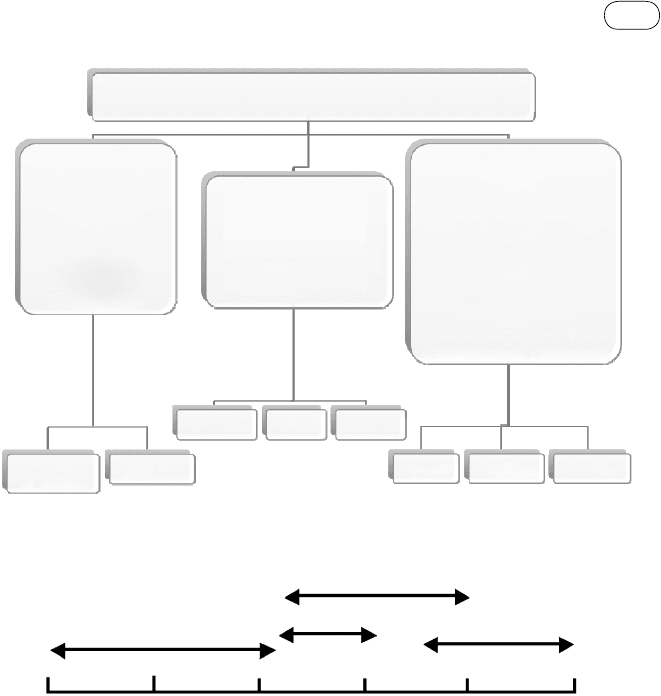
169
6.2 Fixed-Bed/Moving-Bed Gasifiers
types of gasifiers developed with data from Maniatis (2001) and Knoef (2005).
Crossdraft gasifiers are for the smallest size while entrained flow are the largest
size gasifiers.
6.2 FIxed-Bed/MovInG-Bed GasIFIers
In entrained-flow and fluidized-bed gasifiers, the gasifying medium conveys
the fuel particles through the reactor, but in a fixed-bed (also known as moving-
bed) gasifier the fuel is supported on a grate (hence its name). This type is also
called moving-bed because the fuel moves down in the gasifier as a plug. Fixed-
bed gasifiers can be built inexpensively in small sizes, which is one of their
major attractions. For this reason, large numbers of small-scale moving-bed
biomass gasifiers are in use around the world.
Entrained flow
Moving bed
Gasification Technologies
Fluidized bed
• Koppers-Totzek
gasifier
• Seimens SFG
gasifier
• E-gas gasifier
• MHI gasifier
• EAGLE gasifier
• Lurgi dry-bottom
gasifier
• BGL slagging gasifier
Coaxial
downflow
Opposed jet
Updraft
Crossdraft
Bubbling
Circulating
Twin bed
Downdraft
• Winkler process
• KBR transport gasifier
• Twin-reactor gasifier
• EBARA gasifier
• GTI membrane gasifier
• Rotating fluidized-bed
gasifiers
• Internal circulating gasifier
• Foster wheeler CFB
gasifier
FIGure 6.1 Gasification technologies and their commercial suppliers.
Fluid bed
Updraft
Downdraft
Thermal input
10 kW 100 kW 1 MW 10 MW 100 MW 1000 MW
Entrained flow
FIG
ure
6.2
Range of applicability for biomass gasifier types.

170
chapter
|
6 Design of Biomass Gasifiers
Both mixing and heat transfer within the moving (fixed) bed are rather poor,
which makes it difficult to achieve uniform distribution of fuel, temperature,
and gas composition across the cross-section of the gasifier. Thus, fuels that
are prone to agglomeration can potentially form agglomerates during gasifica-
tion. This is why fixed-bed gasifiers are not very effective for biomass fuels or
coal with a high caking index in large-capacity units.
There are three main types of fixed- or moving-bed gasifier: (1) updraft,
(2) downdraft, and (3) crossdraft. Table 6.2 compares their characteristics.
6.2.1 updraft Gasifiers
An updraft gasifier is one of the oldest and simplest of all designs. Here, the
gasification medium (air, oxygen, or steam) travels upward while the bed of
fuel moves downward, and thus the gas and solids are in countercurrent mode.
The product gas leaves from the top as shown in Figure 6.3. The gasifying
medium enters the bed through a grate or a distributor, where it meets with the
hot bed of ash. The ash drops through the grate, which is often made moving
(rotating or reciprocating), especially in large units to facilitate ash discharge.
Chapter 5 describes this process in more detail.
Updraft gasifiers are suitable for high-ash (up to 25%), high-moisture (up
to 60%) biomass. They are also suitable for low-volatile fuels such as charcoal.
Tar production is very high (30–150 g/nm
3
) in an updraft gasifier, which makes
TABLE 6.2 Characteristics of Fixed-Bed Gasifiers
Fuel (wood) Updraft Downdraft Crossdraft
Moisture wet basis (%) 60 max 25 max 10–20
Dry-ash basis (%) 25 max 6 max 0.5–1.0
Ash melting temperature (°C)
>1000 >1250
Size (mm) 5–100 20–100 5–20
Application range (MW) 2–30 1–2
Gas exit temperature (°C) 200–400 700 1250
Tar (g/Nm
3
) 30–150 0.015–3.0 0.01–0.1
Gas LHV (MJ/Nm
3
) 5–6 4.5–5.0 4.0–4.5
Hot-gas efficiency (%) 90–95 85–90 75–90
Turn-down ratio (–) 5–10 3–4 2–3
Hearth load (MW/m
2
)
<2.8
Source: Adapted from Knoef, 2005, p. 26.
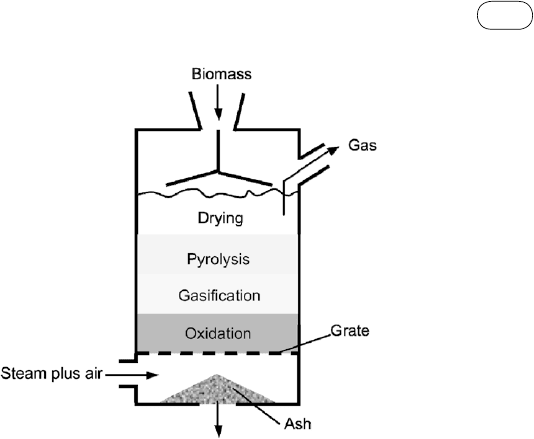
171
6.2 Fixed-Bed/Moving-Bed Gasifiers
it unsuitable for high-volatility fuels. On the other hand, as a countercurrent
unit, an updraft gasifier utilizes combustion heat very effectively and achieves
high cold-gas efficiency (Section 6.11.1). Therefore, it is more suitable for
direct firing, where the gas produced is burnt in a furnace or boiler with no
cleaning or cooling required. Since the gas is not fired in an engine or stored,
the tar produced does not have to be cleaned.
Updraft gasifiers find commercial use in small units like cooking stoves in
villages and in large units like South African Synthetic Oils (SASOL) for pro-
duction of gasoline from coal. The following is a brief description of two
important large-scale commercial updraft gasifier technologies.
Dry-Ash Gasifier
Lurgi, a process development company, developed a pressurized dry-ash updraft
gasifier. It is called dry ash because the ash produced is not molten. One that
produces molten ash is called a slagging gasifier.
Though the peak temperature (in the combustion zone) is 1200 °C, the
maximum gasification temperature is 700 to 900 °C. The reactor pressure is in
the neighborhood of 3 MPa, and the residence time of coal in the gasifier is
between 30 and 60 minutes (Ebasco, 1981). The gasification medium is a
mixture of steam and oxygen, steam and air, or steam and oxygen-enriched air.
It uses a relatively high steam/fuel carbon ratio (~1.5).
The coal is first screened to between 3 and 40
mm (Probstein and Hicks,
2006, p. 162) and then fed into a lock hopper. The gasifying agent moves
upward in the gasifier while the solids descend. The reactor is a double-walled
pressure vessel. Between the two walls lies water that quickly boils into steam
FIGure 6.3 Schematic of an updraft gasifier.

172
chapter
|
6 Design of Biomass Gasifiers
under pressure, utilizing the heat loss from the reactor. As the coal travels down
the reactor, it undergoes drying, devolatilization, gasification, and combustion.
Typical residence time in the gasifier is about an hour (Probstein and Hicks,
2006, p. 162). In a dry-ash gasifier, the temperature is lower than the melting
point of ash, so the solid residue dries and is removed from the reactor by a
rotating grate.
The dry-ash technology has been used at SASOL in South Africa, the
world’s biggest gasification complex. SASOL produces 55 million Nm
3
/day of
syngas, which is used to produce 170,000
bbl/day of Fischer-Tropsch liquid
fuel.
Slagging Gasifier
The British Gas/Lurgi consortium developed a moving-bed gasifier that works
on the same principle as the dry-ash gasifier, except a much higher tempera
-
ture (1500–1800 °C) is used in the combustion zone to melt the ash (hence its
name, slagging gasifier). Such a high temperature requires a lower steam-to-
fuel ratio (~0.58) than that used in dry-ash units (Probstein and Hicks, 2006,
p. 169).
Coal crushed to 5 to 80
mm is fed into the gasifier through a lock hopper
system (Minchener, 2005). The gasifier’s tolerance for coal fines is limited, so
briquetting is used in places where the coal carries too many of them. Gasifica-
tion agents, oxygen and steam, are introduced into the pressurized (~3
MPa)
gasifier vessel through sidewall-mounted tuyers (lances) at the elevation where
combustion and slag formation occur.
The coal introduced at the top gradually descends through several process
zones. The feed is first dried in the top zone and then devolatilized. The
descending coal is transformed into char and then passes into the gasification
(reaction) zone. Below this zone, any remaining carbon is oxidized, and the ash
content is liquefied, forming slag. Slag is withdrawn from the slag pool through
an opening in the hearth plate at the bottom of the gasifier vessel. The product
gas leaves from the top, typically at 400 to 500 °C (Minchener, 2005).
6.2.2 downdraft Gasifiers
A downdraft gasifier is a co-current reactor where air enters the gasifier at a
certain height below the top. The product gas flows downward (giving the name
downdraft) and leaves through a bed of hot ash (Figures 6.4 and 6.5). Since it
passes through the high-temperature zone of hot ash, the tar in the product gas
finds favorable conditions for cracking (see Chapter 4). For this reason, a
downdraft gasifier, of all types, has the lowest tar production rate.
Air from a set of nozzles, set around the gasifier’s periphery, flows down-
ward and meets with pyrolyzed char particles, developing a combustion zone
(zone III shown schematically in Figure 6.5 and described in the discussion of
throatless downdraft gasifiers that follows) of about 1200 to 1400 °C. Then the
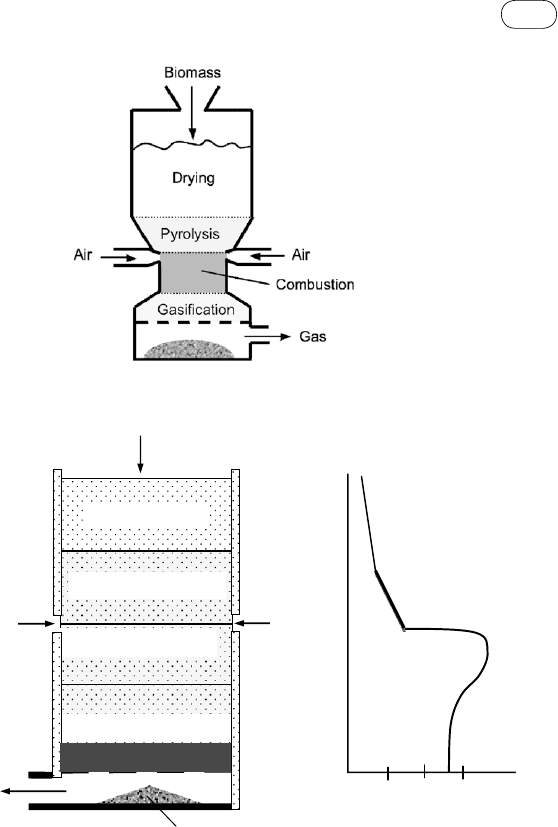
173
6.2 Fixed-Bed/Moving-Bed Gasifiers
gas descends further through the bed of hot char particles (zone IV), gasifying
them. The ash produced leaves with the gas, dropping off at the bottom of the
reactor.
Downdraft gasifiers work well with internal-combustion engines. The
engine suction draws air through the bed of fuel, and gas is produced at the
end. Low tar content (0.015–3 g/nm
3
) in the product gas is another motivation
for their use with internal-combustion engines. A downdraft gasifier requires a
shorter time (20–30 minutes) to ignite and bring the plant up to working tem-
perature compared to the time required by an updraft gasifier.
FIGure 6.4 Schematic of a throated-type downdraft gasifier.
I Biomass fuel
II Flaming pyrolysis
III Char combustion
IV Char gasification
Biomass
500
1000
1500
Temperature (°K)
Air nozzles
Air
Product gas
Ash
FIGure 6.5 Schematic of the operation of a throatless downdraft gasifier. Temperature gradient
along the height shown at the right.

174
chapter
|
6 Design of Biomass Gasifiers
There are two principal types of downdraft gasifier. The throatless (or open
core) type is illustrated in Figure 6.5. Reactions in different zones and at dif-
ferent temperatures are plotted on the right. The throated (or constricted) type
is shown in Figure 6.4.
Throatless Gasifier
This gasifier type is also called open top, or stratified throatless. Here, the top is
exposed to the atmosphere, and there is no constriction in the gasifier vessel
because the walls are vertical. Figure 6.5 shows that a throatless design allows
unrestricted movement of the biomass down the gasifier, which is not possible in
the throated type shown in Figure 6.4. The absence of a throat avoids bridging or
channeling. Open-core is another throatless design, but here air is not added from
the middle as in other types of downdraft gasifiers. Air is drawn into the gasifier
from the top by the suction created downstream of the gasifier. Such gasifiers are
suitable for finer fuels—for example, lighter biomass such as rice husk.
The following are some of the shortcomings of a downdraft gasifier:
It operates best on pelletized fuel instead of fine light biomass.
The moisture in the fuel must not exceed 25%.
A large amount of ash and dust remains in the product gas.
As a result of its high exit temperature, it has a lower gasification
temperature.
Operating Principle
Because an open-top, or a throatless, gasifier is simple in construction, it is used
to describe the gasification process in the downdraft gasifier (Figure 6.5). The
throatless process can be divided into four zones (Reed and Das, 1988, p. 39).
The first, or uppermost, zone receives raw fuel from the top that is dried in air
drawn through the first zone. The second zone receives heat from the third zone
principally by thermal conduction.
During its journey through the first zone, the biomass heats up (zone I in
Figure 6.5). Above 350 °C, it undergoes pyrolysis, breaking down into charcoal,
noncondensable gases (CO, H
2
, CH
4
, CO
2
, and H
2
O), and tar vapors (condens-
able gases). The pyrolysis product in zone II receives only a limited supply of
air from below and burns in a fuel-rich flame. This is called flaming pyrolysis.
Most of the tar and char produced burn in zone III, where they generate heat
for pyrolysis and subsequent endothermic gasification reactions (Reed and Das,
1988, p. 28).
Zone III contains ash and pyrolyzed char produced in zone II. While passing
over the char, hot gases containing CO
2
and H
2
O undergo steam gasification
and Boudouard reactions, producing CO and H
2
. The temperature of the down-
flowing gas reduces modestly, owing to the endothermic gasification reactions,
but it is still above 700 °C.
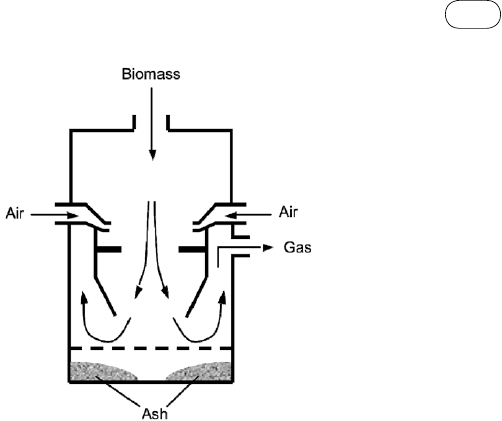
175
6.2 Fixed-Bed/Moving-Bed Gasifiers
The bottommost layer (zone IV) consists of hot ash and/or unreacted char-
coal, which crack any unconverted tar in this layer. Figure 6.5 shows the reac-
tions and temperature distribution along the gasifier height. In one version of
the throatless downdraft gasifier, the open-core type, the air enters from the top
along with the feed. This type is free from some of the problems of other
downdraft gasifiers.
Throated Gasifier
The cross-sectional area of a throated (also called constricted) gasifier is
reduced at the throat and then expanded, as shown in Figure 6.4. The purpose
is for the oxidation (combustion) zone to be at the narrowest part of the throat
and to force all of the pyrolysis gas to pass through this narrow passage. Air is
injected through nozzles just above the constriction. The height of the injection
is about one-third of the way up from the bottom (Reed and Das, 1988, p. 33).
The movement of the entire mass of pyrolysis product through this hot and
narrow zone results in a uniform temperature distribution over the cross-section
and allows most of the tar to crack there. In the 1920s, a French inventor,
Georges Imbert, developed the original design, which is popularly known as
an Imbert gasifier (Figure 6.6).
The fuel, fed at the top, descends along a cylindrical section that serves as
storage. The air pyrolyzes the biomass and burns the pyrolysis product or some
charcoal. The hot char and the pyrolysis product pass through the throat, where
most of the tar is cracked and the char is gasified. Figure 6.6 showed a flat-type
throat construction, but it can be a V-type like in Figure 6.4.
FIGure 6.6 Constricted downdraft gasifier (Imbert type). Air/oxygen is added through nozzles
around the vessel just above the constriction. (Source: Adapted from Reed and Das, 1988, p. 39.)
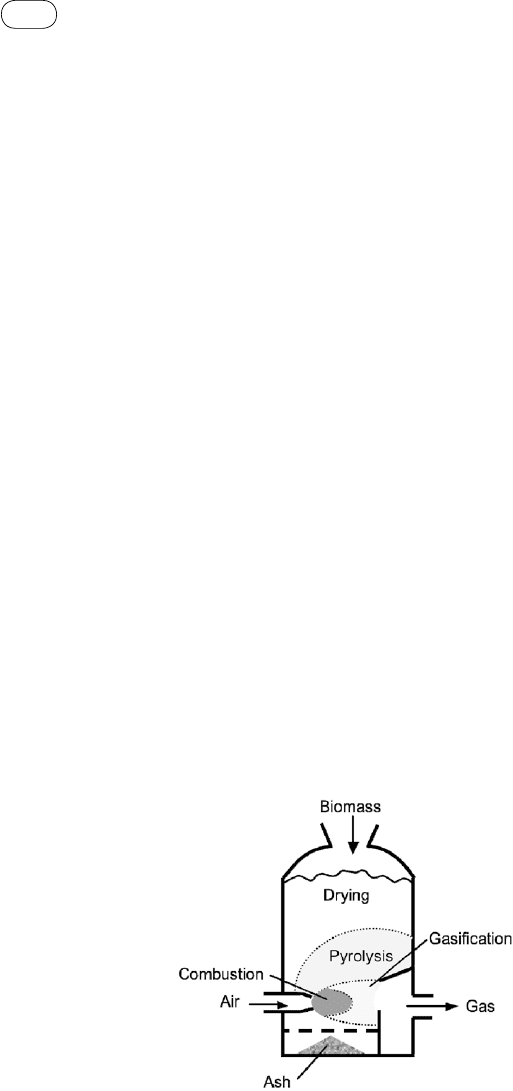
176
chapter
|
6 Design of Biomass Gasifiers
Throated downdraft gasifiers are not suitable for scale-up to larger sizes
because they do not allow for uniform distribution of flow and temperature in
the constricted area. Beyond 1 MWth capacity, an annular constriction can be
employed, but this has not been the practice to date.
6.2.3 crossdraft Gasifiers
A crossdraft gasifier is a co-current moving-bed reactor, in which the fuel is
fed from the top and air is injected through a nozzle from the side (Figure 6.7).
It is primarily used for gasification of charcoal with very low ash content.
Unlike the downdraft and updraft types, it releases the product from its side
wall opposite to the entry point of the air for gasification. Because of this con-
figuration, the design is also referred to as sidedraft. High-velocity air enters
the gasifier through a nozzle set at a certain height above the grate. Excess
oxygen in front of the nozzles facilitates combustion (oxidation) of part of the
char, creating a very-high-temperature (>1500 °C) zone. The remaining char is
then gasified to CO downstream in the next zone (Figure 6.7). The product gas
exits from the opposite side of the gasifier. Heat from the combustion zone is
conducted around the pyrolysis zone, so the fresh biomass is pyrolyzed while
passing through it.
This type of gasifier is generally used in small-scale biomass units. One of
its important features is a relatively small reaction zone with low thermal capac-
ity, which gives a faster response time than that of any other moving-bed type.
Moreover, startup time (5–10 minutes) is much shorter than in downdraft and
updraft units. These features allow a sidedraft gasifier to respond well to load
changes when used directly to run an engine. Because its tar production is low
(0.01–0.1
g/nm
3
), a crossdraft gasifier requires a relatively simple gas-cleaning
system.
FIGure 6.7 Schematic of a crossdraft gasifier.
